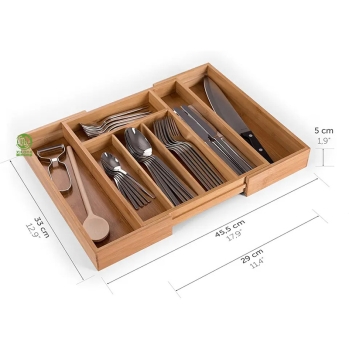Bamboo vs Plastic Products: Which Should You Choose for Your Home?
Standing in the kitchen aisle trying to decide between bamboo and plastic products can be honestly confusing. Both materials are common in everything from cutting boards to storage containers, but they perform very differently in real-world use. Understanding the key differences helps you make better choices for your home and budget.
Durability and Lifespan
Plastic products often seem like the economical choice because of their lower initial cost. However, plastic cutting boards, utensils, and containers typically show wear much faster than bamboo alternatives. Plastic develops deep scratches that harbor bacteria, becomes stained, and often cracks or breaks within a year or two of regular use.
Bamboo products last significantly longer under the same conditions. A quality bamboo cutting board can serve you well for 5-7 years or more with basic care. Bamboo utensils resist wear and maintain their smooth finish through thousands of uses. While you might pay more upfront for bamboo, the longer lifespan usually makes it the better value.
Hygiene and Food Safety
This is where bamboo really shines compared to plastic. Those scratches that develop on plastic cutting boards and utensils create perfect hiding spots for bacteria. Even thorough washing can't always reach deep into these grooves, potentially creating food safety issues.
Bamboo contains natural antimicrobial properties that actively resist bacteria growth. The smooth, dense surface of bamboo products doesn't develop the same deep scratching as plastic. Many professional chefs prefer bamboo cutting boards specifically because they stay more hygienic over time. For families concerned about food safety, this difference matters.
Environmental Impact
The environmental comparison heavily favors bamboo. Plastic products are made from petroleum, don't biodegrade, and contribute to long-term pollution. Even recyclable plastics often end up in landfills where they'll remain for hundreds of years.
Bamboo grows rapidly without pesticides or excessive water, making it a renewable resource. When bamboo products eventually wear out, they decompose naturally within a few years. Choosing bamboo over plastic means less waste in landfills and a smaller carbon footprint for your household.
Heat Resistance
Plastic's biggest weakness shows up around heat. Plastic utensils can melt when left in hot pots, plastic cutting boards warp in the dishwasher, and plastic containers sometimes release chemicals when heated. These limitations restrict how you can use plastic products safely.
Bamboo handles heat much better. Bamboo utensils work safely with hot cookware without melting or warping. You can place hot pans on bamboo trivets without damage. This heat resistance makes bamboo products more versatile and reliable in busy kitchens.
Maintenance Requirements
Plastic products seem low-maintenance initially – just toss them in the dishwasher. However, repeated dishwasher cycles often degrade plastic quickly, causing warping, discoloration, and brittleness. The convenience of machine washing comes with a shorter product lifespan.
Bamboo requires hand washing and occasional air drying, which sounds like more work but only adds a minute or two to cleanup. This simple care routine keeps bamboo products in excellent condition for years. Smart shoppers realize that spending a few extra seconds on care saves money by extending product life significantly.
Appearance Over Time
New plastic products look clean and modern, but they don't age well. Plastic becomes cloudy, stained, and scratched relatively quickly. These visual changes often prompt replacement even when the product is still functional, creating unnecessary waste and expense.
Bamboo products actually develop character with age. The natural material takes on a warm patina that many people find attractive. Even after years of use, bamboo maintains a pleasant appearance that doesn't look worn out or cheap. This aging quality means you won't feel pressured to replace items that still work perfectly.
Weight and Feel
Plastic products feel light and sometimes flimsy, which can affect your cooking experience. Plastic cutting boards slide around on counters, and plastic utensils don't provide the substantial feel that many cooks prefer.
Bamboo offers a better weight and balance. Bamboo cutting boards stay put during use, and bamboo utensils feel solid and comfortable in your hand. This substantial quality makes cooking tasks easier and more enjoyable, which matters when you use these products daily.
Cost Comparison Reality
Initial price comparisons favor plastic, but this creates misleading conclusions. A plastic cutting board might cost $10 and last two years, while a $30 bamboo cutting board lasts seven years. The bamboo option actually costs less per year while performing better throughout its life.
When you factor in the hygiene benefits, environmental advantages, and superior performance of bamboo, the value proposition becomes even clearer. Bamboo represents smart spending rather than unnecessary expense.
Safety Considerations
Plastic products can contain chemicals like BPA that may leach into food, especially when heated or scratched. While many manufacturers now offer BPA-free plastic, concerns about other chemicals in plastic products continue to emerge.
Bamboo is a natural material without synthetic additives or concerning chemicals. For families with young children or anyone concerned about chemical exposure, bamboo provides peace of mind that plastic simply cannot match.
The Clear Winner for Most Uses
While plastic products have their place, bamboo wins the comparison for most kitchen and household applications. The combination of durability, hygiene, environmental benefits, and long-term value makes bamboo the smarter choice for cutting boards, utensils, and many other household items. Your initial investment in bamboo products pays off through years of reliable use and the satisfaction of making a more responsible choice.







